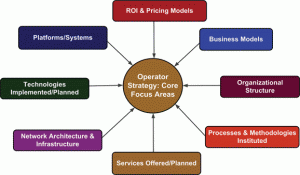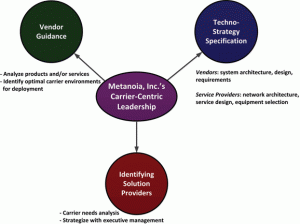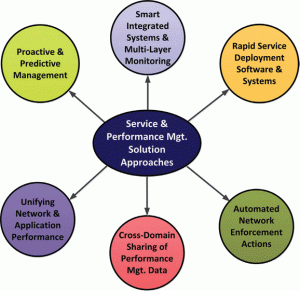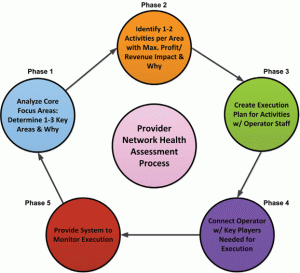 Dr. Vishal Sharma
Dr. Vishal Sharma
Principal – Metanoia
Dr. Vishal Sharma, Principal at Metanoia, Inc. in Silicon Valley, is a seasoned international telecom industry expert with global exposure, who has executed assignments for clients on 4 continents, and, over two decades, has played multi-faceted roles, including: entrepreneur, technologist, technical leader, academic, educator, technology writer & editor, speaker, and researcher.
Metanoia, Inc., a leader in bringing focus to carrier-centric issues for over a decade, uses its unique assessment framework, deep-knowledge of the full service provider eco-system, and elite team of world-class experts to help operators and vendors make sound strategic and technical decisions that are critical to grow, sustain profitability, and thrive in the long-run.
They help clients accelerate technology design and development or network design and deployment, master complex technologies, slash learning cycles, speed time-to-market, & enhance customer-interactions, thereby increasing profits and productivity in ways that are financially measureable.
They work with network planning & design and network engineering and operations at carriers or with systems engineering, product planning, and product management at vendors, to accelerate next-generation network/systems requirements, analysis, architecture, and design. Metanoia, Inc. also work closely with executive & engineering management and technical leaders to speed-up product development/service deployment, using their deep technology base, extensive market knowledge, and 360-degree perspective.
Q: As you mentioned that a burning question before carrier executives today is: “How do we efficiently operate networks that perform optimally and provide an excellent end-user experience, while lowering our total cost of ownership (TCO) and increasing profitability?” How do you address this using your provider network health assessment framework, which we’ve been hearing about lately?
A: Service provider executives today undoubtedly face a barrage of critical questions. Upon analyzing these, with our decade rich experience in the telco eco-system, we realized two vital facts:
 First, answering these requires a systematic analysis of their business and technology, which is often lacking.
First, answering these requires a systematic analysis of their business and technology, which is often lacking.
This begs a framework that will allow them to examine the two holistically, and analyze their interconnections. So we cleverly condensed a carrier’s operations into a set of core focus areas (Figure 1) that are fundamental to its business but independent of operator- type, size, geography or vertical. Our framework enables an efficient resolution of carrier issues by mapping each to a core area(s), and then furnishing an effective plan to streamline operations.
Second, with diversity in systems & technology, industry-wide cooperation is the key to crack hard problems. The industry needs to come together in a collaborative environment to contemplate solutions to demand operator issues, a philosophy that underpins our many leading initiatives.
Q: How does your framework apply in the service delivery and service management arena, and how do you help operators there?
A: In the service- and performance-management arena this framework is critical. Smart strategies to keep the network and its services running smoothly are vital and the foundation of an operator’s network management plan.
For example, depending on a carrier’s specific situation, health assessment would help decide whether it needs to deploy better network management systems, or deploy existing systems better, or operate them better, or perform measurements better, or enhance its back-end OSS/BSS or monitoring systems to perform proactive management. Each of the preceding actions could markedly improve network health, and, thereby, operational cost.
We help operators (Figure 2) here by: (a) using our historical insight into the eco-system and our framework to incisively hone-in on a carrier’s business and technology environment and needs, and (b) using our deep understanding of solution providers to immediately identify the best players and strategies to meet those needs.
Likewise, because we have a fundamental understanding of a range of solutions and their applicability in multiple operator classes, we can also guide solution providers about carriers that are best-suited to utilize their solutions.
The three mini case studies ahead demonstrate how we serve as a bridge between carriers and solution providers, using our expertise and our 360°-perspective on operator needs to benefit both.
 Q: In the smart monitoring and performance management space you just spoke about, what do you see as key trends in the state-of-the-art? Why?
Q: In the smart monitoring and performance management space you just spoke about, what do you see as key trends in the state-of-the-art? Why?
A: First, let me reiterate that agile monitoring/management is essential to keep the network operational, and should form the basis of a carrier’s customer experience management plan.
With the growing diversity of services and technologies, we see three advances in the state-of-the-art helping operators immensely (see Figure 3 for a list of emerging areas, and 4 for details):
● Proactive & Predictive Management
● Smart, Integrated Systems with Multi-Layer Monitoring
● Rapid Service Deployment Software and Systems
Let us see why.
Most carrier operations today are reactive, meaning the staff acts after an outage or break occurs. A 2010 Telcordia study pegged the cost per network-downtime incident as high as $750,000, which adds up fast! (Witness the O2 and Orange outages in July, which caused much customer consternation and carrier expense.) The three developments above, address this.
With proactive diagnosis and reporting, changes in: configuration, logical entities, and performance could be reported to the operator in advance, so that anomalies are handled ahead of actual trouble. Deviations of the operational network from the designed baseline or impairments in end-user application performance could be detected in real-time, enabling proactive (and eventually predictive) action, saving the carrier millions in cost, lost revenue, and damages.
 Smart integrated systems, likewise, consolidate multiple layers, e.g. DWDM, SONET/SDH, ATM, Ethernet and IP, in a single system, saving capex. Additionally, they can now incorporate multi-layer monitoring capabilities, and, via smart software, can expose monitored parameters through a single portal, giving the operator superior visibility of network layers, and simplifying management and fault correlation. This speeds fault resolution and service restoration, directly helping the carriers’ bottom line.
Smart integrated systems, likewise, consolidate multiple layers, e.g. DWDM, SONET/SDH, ATM, Ethernet and IP, in a single system, saving capex. Additionally, they can now incorporate multi-layer monitoring capabilities, and, via smart software, can expose monitored parameters through a single portal, giving the operator superior visibility of network layers, and simplifying management and fault correlation. This speeds fault resolution and service restoration, directly helping the carriers’ bottom line.
Finally, the operator environment is becoming highly dynamic, with time-varying demands e.g., streaming VoD, webcasting events, or replicating a data center, which requires network agility, the rapid creation of on-demand virtual networks with time-limited bandwidth reservations. To provide such services, network resources must be exposed to software applications. This gives the operator visibility and flexibility in bandwidth usage and managing network assets, and a pay-for-use capability yielding precious savings.
 Our partners, e.g. OPNET Technologies, BTI Systems, Cariden, play key roles above.
Our partners, e.g. OPNET Technologies, BTI Systems, Cariden, play key roles above.
Q: You spoke of three key evolving trends/capabilities in the service and performance management space. Could you share some examples or case studies that would illustrate which operator environments these are most applicable for, and some representative solution providers that an operator may rely on to instantiate these capabilities?
A: Absolutely!
April 28, 2025











